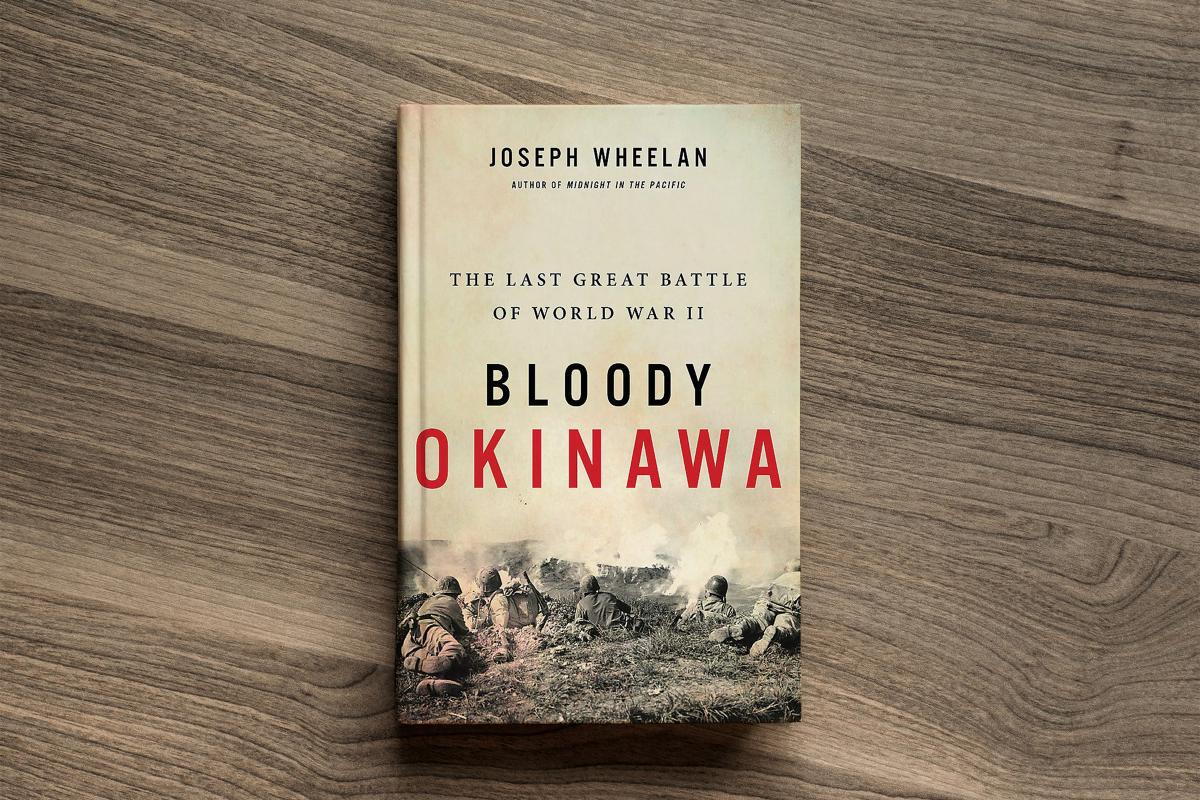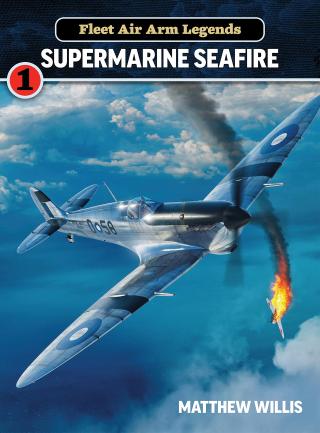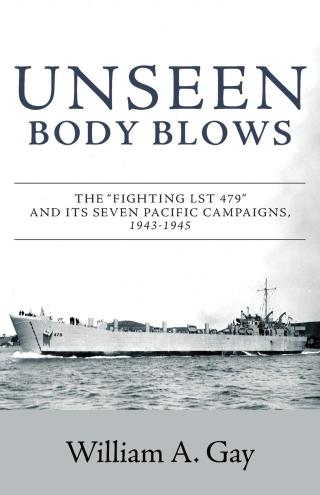Bloody Okinawa: The Last Great Battle of World War II
Joseph Wheelan. New York: Hachette Books, 2020. 419 pp. Photos. Maps. Notes. Biblio. Index. $40.
Reviewed by Captain Chris Hemler, U.S. Marine Corps
On 1 April 1945, Allied forces launched the largest amphibious assault of the Pacific war. If successful, the invasion of Okinawa promised several strategic spoils. First, the island’s location would enable U.S. air forces to strike Japan proper with medium bombers and complete fighter coverage. Second, Okinawa would provide an ideal site for the Allies to mass combat power—land, sea, and air—in preparation for Operation Downfall, the impending invasion of the Japanese Home Islands. In Bloody Okinawa, accomplished nonfiction author and former Associated Press reporter Joseph Wheelan delivers an encompassing study of the campaign.
U.S. forces under Army General Simon Bolivar Buckner Jr. made up the unprecedented 183,000-man assault force. At first, the landing exceeded the Allies’ most optimistic projections. By nightfall on 3 April, the Americans had reached their 15 April objectives. In the northern sector, the 6th Marine Division advanced so rapidly that its supporting artillery struggled to keep apace.
The relatively quiet landing was a calculated move on the part of General Mitsuru Ushijima and the 32nd Army defending Okinawa. The struggle soon became a grisly and monotonous affair. Having yielded the beach, Japanese forces intended to fight and die—yard by yard—across the island’s menacing interior. In the south, Okinawa’s terrain precluded effective tank support. In the north, U.S. Marines on the Motobu Peninsula turned to flamethrowers, satchel charges, and hand grenades to clear stubborn enemy caves. The battle, and its horrors, intensified.
By mid-April, the fight ashore was both personal and brutal. Japanese forces withdrew to and then retreated from the hardened “Shuri Line” across central Okinawa. The battle wore on. By May, the island’s weather added its own hardships to the contest. Springtime rains produced treacherous, waist-deep mud. Foot marches became arduous, motorized operations impossible. The deluge delayed but did not prevent the outcome. On 21 June, the Americans declared the island secure.
In some accounts, Okinawa is remembered as a massive, protracted inland campaign. But Bloody Okinawa helps to reset the balance by highlighting the contest at sea and in the air. Wheelan carefully narrates Operation Kikusui, a series of ten major kamikaze attacks meant to paralyze the Allied fleet off Okinawa. The author also captures the climactic sinking of the Imperial Japanese Navy’s crown jewel, the Yamato. With U.S. carrier pilots swarming the battleship “like gnats,” Japanese sailors abandoned ship. The Yamato’s captain retired to his quarters and shot himself. In an act representative of the vicious conflict, U.S. pilots strafed helpless enemy survivors in the water (a gruesome act Japanese airmen would return in-kind just days later). Fewer than 300 of the Yamato’s original crew of 3,332 survived. For the sailors, airmen, and infantrymen who lived to see the fight for Okinawa, the war promised no quarter.
Much of the ground Wheelan tills in Bloody Okinawa exists elsewhere in the vast literature on the Pacific war. He covers well-known events such as the heroic exploits of Army medic Desmond Doss, featured in Mel Gibson’s 2016 film Hacksaw Ridge, and General Buckner’s unlikely death in mid-June. The maps are rudimentary and unattractive; nonetheless, Wheelan’s rendering is fair and comprehensive. The author relies on firsthand descriptions from U.S. and Japanese participants, and Okinawan civilians. He captures both the drama and the horror of the battle as his characters struggle with death, misery, and utter exhaustion on and around the island.
In comfortable prose, Wheelan delivers an entertaining synthesis that elevates the human experience. Bloody Okinawa is a stirring and accessible study of one of the most important campaigns in 20th-century military history.
Capt Hemler is a Marine officer and instructor assigned to the History Department at the U.S. Naval Academy. He is a PhD candidate in history at Texas A&M University, focusing his studies on amphibious operations, military adaptation, and the Pacific war.
Fleet Air Arm Legends 1: Supermarine Seafire
Matthew Willis. 114 pp. Horncastle, UK: Tempest Books, 2020. Photos. Drawings. $19.99.
Reviewed by J. M. Caiella
Supermarine Seafire by Matthew Willis is the first in a new series of “bookazines”—Fleet Air Arm Legends—printed by Tempest Books, a long-established British publishing house. Willis, primarily an author of historical fiction, has completed five monographs of other Fleet Air Arm aircraft with another publisher.
This may be the first publication of the word “bookazine” in Naval Institute print. Back in the day—yesterday—the term was monograph, a book that homed in on one subject or, even deeper, an aspect of a given subject. The bookazine is not necessarily as focused as a monograph and combines elements of a book with those of a magazine. In this instance, it appears to be a 114-page softcover monograph printed on slick, thick, semigloss stock, which allows for excellent image reproduction, with no bleed-through.
The Seafire, despite its lineage derived from the fabled Supermarine Spitfire, is relatively little known on this side of the Atlantic. Willis does an admirable job of describing the two branches of the Seafire, the Royal Navy’s adaptation of the storied aircraft to sea duty. Initially, with a great need for an interceptor—as opposed to a fighter—to protect its sea forces, the Royal Navy simply strapped on an arresting hook to the tail of a Spit. Thus the first Seafires were simply “hooked” Spitfires.
The Spitfire was an unlikely candidate for carrier use; it lacked range and endurance, and its narrow landing gear track made it extremely difficult to land on a ship. At the time, however, there was no other choice. The first of the Seafire variants, the Mk Ib, had no folding wings, no catapult launch fittings, indeed nothing to separate it from its land-based brethren except for a literally tacked-on arrestor hook.
Willis’s narrative traces this history in parallel with the true Seafire, which incorporated a specifically designed tailhook but also the detail changes required for navalization. These changes included catapult fittings, air intake shutter, signal cartridges, beacon receivers, and naval radio sets including a continuous wave transmitter with Morse key.
Converting an aircraft for sea is one thing, but putting it into operational use reveals myriad issues previously unconsidered. These aspects are a focus of Willis’s work. For instance, unlike U.S. carrier operations policy, the British believed in hangar stowage for all their aircraft. When land planes were adapted for naval use, first with the Hawker Hurricane, the Royal Navy could not strike them below deck because they would not fit on the aircraft elevators. Deck space was freed by stowing these aircraft on outriggers, which were channel beams that extended over the ship’s side with the aircraft’s tail wheel firmly secured. In September 1942, HMS Victorious and Formidable each carried six Seafires in this manner. (In 1933, the USS Ranger [CV-4] was completed with outriggers, and they were used on some Essex-class carriers during World War II.)
One field modification involved trimming about three inches from the end of each propeller blade. The arresting hook, of necessity, was placed in front of the tail wheel and closer to the aircraft’s center of gravity. This had the nasty habit of having the propeller “pecking” at the deck on landing. During the invasion of Sicily, no less than 55 propellers had been damaged. On later versions, the hook was moved aft to the tail and the aircraft received four-blade propellers of smaller diameter.
Another interesting workaround concerned the aircraft’s flaps at takeoff. The Spitfire’s flaps had just two settings, full up or full down, and thus were useful only in landing. Carrier takeoffs required as much help as possible, thus a “field expedient” was incorporated. A small wooden wedge was inserted between the flap and wing, which gave it 18 degrees of down flap for takeoff. Once airborne, the pilot would fully lower, then retract the flaps. The wedges were blown away in the airstream.
These vignettes are woven into the fabric of Willis’s narrative, which is a decently written tale of virtually two aircraft. The monograph is amply illustrated with crisp photographs, one in vintage color, and 13 color profile drawings. Covering a little-known subject on this side of the “pond,” at $20, it is a very reasonable addition to your aviation library.
Mr. Caiella is a journalist with more than 45 years experience. He has worked as lead editor of scholarly publications for the Naval History and Heritage Command, senior editor of Proceedings and Naval History magazines, and writer-editor for the U.S. Marine Corps’ History Division.
Unseen Body Blows: The ‘Fighting LST 479’ and Its Seven Pacific Campaigns, 1943–1945
William A. Gay. Victoria, BC: FriesenPress, 2019. 270 pp. Illus. Sources. $21.99.
Reviewed by Major Timothy G. Heck. U.S. Marine Corps
General Omar Bradley’s alleged quote, “Amateurs study tactics, professionals study logistics,” comes to mind when reading William Gay’s Unseen Body Blows: The ‘Fighting LST 479’ and Its Seven Pacific Campaigns, 1943–1945. The landing ship, tank (LST) likely will never get the attention of the aircraft carriers, submarines, or battleships of World War II, much to the detriment of our understanding of logistics in war. Gay’s detailed account of a new and untested ship being crewed by new and untested sailors is a reminder that unheralded workhorses played a crucial role in U.S. amphibious campaigns across the Pacific. Gay has a personal connection to LST-479, on board which his father served as a communications officer. Based on his father’s unfinished manuscript and supplemented by additional research, Unseen Body Blows is an engaging and well-researched book that recounts an aspect of the war largely absent in other texts. Gay’s background as a journalist helps personalize the narrative of the officers and men who sailed LST-479 into combat.
By the end of World War II, more than 1,000 LSTs had been built and had served in every theater in unsung yeoman’s roles. At Normandy, for example, 144 LSTs evacuated nearly 80 percent of Allied casualties in the first 11 days. LST-479 was laid down at Henry J. Kaiser’s Richmond Shipyard Number Four in Richmond, California, and was launched in spring 1943. As with many early-war projects, LST-479 was hastily built in a shipyard not fully prepared for constructing warships. Described as “a big, huge bathtub,” she initially was crewed by inexperienced officers. Only the commanding officer, a lieutenant, had previous experience at sea. Most of the sailors, officers, and enlisted were recently civilians.
The crew’s inexperience showed on their initial cruises around California. Among other incidents, LST-479 crashed into a dock, almost hit a tugboat, shot at an airplane towing an air target, and missed the Farallon Islands off the coast of California, becoming lost for a few hours before eventually locating San Francisco. By July 1943, however, she was deemed ready for action and sailed north to participate in the U.S. operation against Japanese-occupied Kiska in the Aleutian Islands. Here, the LSTs proved their value and worth to U.S. operations, even if the Navy was still working out how to employ them.
LST-479’s second and third campaigns were supporting landings in the Gilbert and Marshall islands during late 1943 and early 1944. During the Gilbert campaign, she landed Army units on Makin Island the day after Marines landed at Tarawa. After a respite in Hawaii following Makin, LST-479 landed Marines of the 15th Defense Battalion who were to defend Roi and Namur islands after their seizure in February 1944. A fourth campaign shortly thereafter saw her supporting Army General Douglas MacArthur’s operations in Hollandia, New Guinea. Operations against Guam, in the Philippines, and landings at Okinawa saw the ship through to the end of the war.
Gay’s writing style and use of primary sources brings to life the war for LST-479’s crews. The hastily designed and built LSTs were mechanically problematic ships that consistently broke down, lost power, and straggled behind in convoys. Nevertheless, their cargo capacity and low draft made them indispensable for transporting soldiers, Marines, supplies, and equipment onto recently seized beachheads. As the Navy plans to return to a 355-ship fleet, senior planners would be well served to read histories such as Unseen Body Blows to be reminded that naval power projection means more than just aircraft carriers, cruisers, and submarines.
Maj Heck is a Marine field artillery officer by training. He is coeditor of the recently released On Contested Shores: The Evolving Role of Amphibious Operations in the History of Warfare (Marine Corps University Press, 2020).





